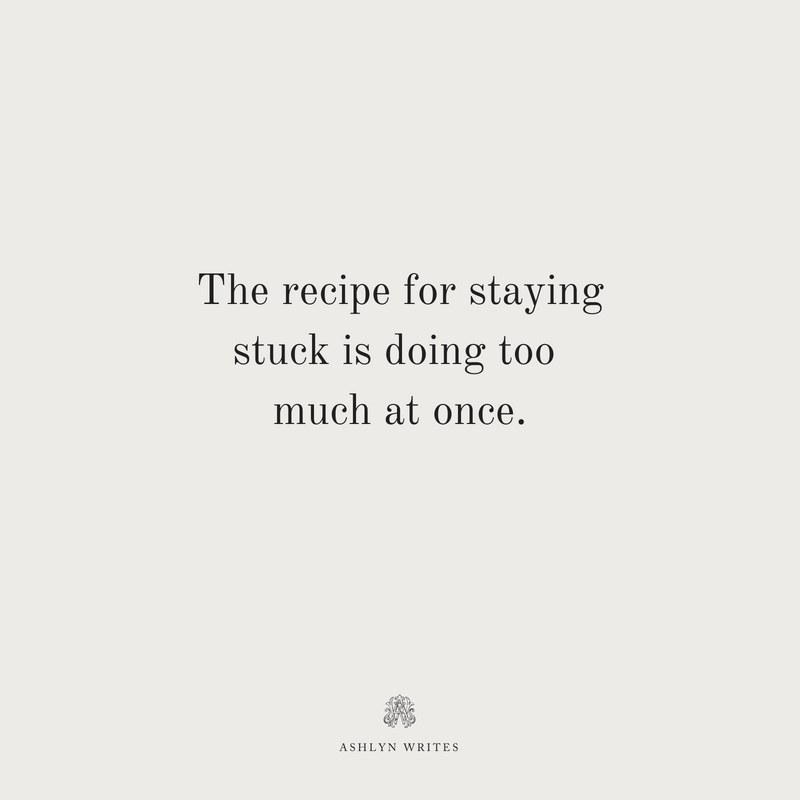“Ashlyn, when do you know its time to hire an assistant? How much were you making on your own before you brought in help?”
You asked, and I’m answering.

This topic makes me so happy!
So, you know that I like to talk about sales copy as a copywriter, and how to leverage your words to make more sales in your business, BUT … I can’t ever talk about that without mentioning the bigger picture: and that’s why I’m so passionate about this.
Today, we’ll dig into:
- Why you need to know your hourly rate
- 5 workflow ideas you may not have thought of
- How to set up a time tracking system
And more!
Don’t forget to grab the FREE Top 5 Things to Outsource in Your Biz (to Bring You Big Profits) Checklist!
5 Ways to Get Ready to Hire an Assistant
My Journey with Outsourcing
I remember the first time I thought about hiring: I immediately assumed it was only for the big girls …
… and I was soooooo far away from that.
(Spoiler: I was wrong.)
I heard about “outsourcing,” and just assumed that meant paying someone a lot of money to be on your team (I totally didn’t even think of contracting). I was bootstrapping EVERYTHING in my business: designing every graphic, spending hours each Friday meticulously entering every expense and client payment into a spreadsheet, hand-reviewing each of the thousands of envelopes for calligraphy clients, and more.
You get it, right?

Over time, I realized I was making a mistake. I was spent out, nearing burn-out, and felt like that adage that Barbara Corcoran from Shark Tank says: I’d left working 40 hours for someone, just to work 80 hours for myself.
[bctt tweet=”Entrepreneurs are willing to work 80 hours a week to avoid working 40 hours per week.” username=”via AshlynSCarter”]
I started getting more comfortable spending money on software (CoSchedule, HoneyBook, Acuity, etc.), and realized that sure, it set me back in my monthly budget, but with the freed up time, I could make more money.
That’s when the idea of my hourly rate started to click.
If I could pay someone to do something more quickly (aaaand typically better!) than I was doing it, and put that time towards my money-making tasks, we made more money.
So, here’s what happened:
- I spent $200 (that was a HUGE commitment then!) on a graphic designer to create 4 workbook templates for me after 6 months in business, when my business hadn’t yet replaced my full-time salary.
- I started paying someone $25/hour to spell/fact check and pack all of our calligraphy orders after 10 months in business. Still hadn’t replaced my corporate salary of $60k—the business was ALMOST making that, but my take-home definitely wasn’t.
- I hired bookkeeping out for $350 a month after 11 months in business. Again, I wasn’t at my take-home of $60k like I was in corporate yet.
I bring that up because I would have never broken that threshold if I didn’t start getting things off my plate.
Those 3 little steps—the first things I outsourced—got my feet wet and helped me see that “growing a team” wasn’t so far out of reach after all.
Your time as a creative is so, so valuable. The more time you can spend focusing on the things that help really move the needle on your income, the better.
So, I thought it would be kind of cool to talk about how you can start staying in your zone of genius. SO FUN!
Let’s talk about the 5 things to do before YOU start outsourcing!
1. Know how much your time is worth
Calculating your hourly rate is one of the first steps I’m teaching inside my new productivity course The Art of Efficiency™.
If we are creative entrepreneurs, and are NOT hobbyists creating art for art’s sake (which is also a good thing in its time!), we should think about the purpose of business.
A lot of business owners lose sight of that altogether.
But, the purpose of a business is to make money, right? To make more money than is put in, and hopefully a good bit more!
Time must be invested accordingly.
So, spending time calculating this number will give you a measuring stick.
Based off of what Ashlyn Writes has to make to keep the lights on/pay contractors/pay myself/continue to invest in the business, I know EXACTLY (to the random dollar!) how much my hour is worth.
I know that multiplying it by 3 helps me remember that most statistics say that we’re only productive 1/3 the day.
And I know it so when I charge clients and set package prices, I make sure I won’t dip below it.

Now, I agree with this MOST times—but the next tip definitely comes into play, too!
Action Step: Set aside time to figure out how much an hour of your time is worth in your business.
#2 Know what is in your Zone of Genius.
Now, kinda in part with the first one, I DO think there’s merit in knowing enough to be dangerous at first about different tasks before you outsource them.
Like my journey to outsourcing, you’ve done these things too, right? We’ve just about done EVERY job in our business!
However, while there’s merit in knowing enough to be dangerous at first about different tasks before you outsource them, there’s also lots of merit in knowing what tasks aren’t in your wheelhouse.
Of the 100% of tasks that you’re doing, about 20% are truly in your “zone of genius.”
“Limit your daily work to your best work,” Claire Diaz-Oritz says in her book Design Your Day. “We need to try to only do that 20% of things we are really good at that bring us great results, and eliminate the rest from our plate completely.”
It’s a tall order (and true, LIKELY impossible to completely execute), but it really gets your wheels turning, right?
Action Step: Figure out the 20% of things that you’re REALLY good at or that create the big wins. I can’t dig into my process for that here, but I’m teaching a free class about it coming up!
#3 Workflows Recorded & Housed
Next, you’re going to need your workflows recorded and housed somewhere.
Have you ever started a new job and tried to give someone a hand, but they’re so busy doing their work that they don’t have time to stop and train you?
It’s difficult enough to be trained for a job—now imagine doing it without a roadmap!
Before you outsource, spend a lot of time developing the workflows and tasks in your business, cleaning them up, and figuring out where to house them.
You may have thought to create workflows for:
Inboxing
Your client processes (here’s how we put ours in HoneyBook)
Hosting a webinar/FB Live
Blogging (here are 4 tips I wrote about that)
Your social media routing
Editing videos or podcast interviews
Writing newsletters
BUT, I always try to create workflows for out of the box things I do more than once (because I drive myself batty when I can’t remember all the steps!). That’s things like:
Packing for a work trip
Getting booked to speak/booking travel
Going on vacation or out of office
Writing guest posts
Registering a copyright
True, you may be outsourcing to someone who’s more skilled than you in the area you need their help. BUT, I’ve found it was still helpful when I was able to say “this is what I did, so this is what I expect—but now you take this and get to do it your way/better!”
To note, there’s not only one right way to do something. 🙂 Keep that in mind as you get help!
Related: The Best Automation Workflows for Your Creative Business
#4 A Brand Voice Guide
Okay, next up is a document I call your “Brand Voice Guide.”
If you are wanting to have someone in your business speak like you—whether it’s handling your inbox or helping you out with blog posts or social media—you’re going to want to have documentation on hand of what you “sound” like in your business.

Just the other day, we got things ready in the business to work with a business that’s going to help us out with failed customer payments, and do you know what they asked for?
Documentation on our brand voice.
😉
This is something we spend a whole lesson on inside my Copywriting for Creatives™ program, but basically, I want you to have your own “Demo Day,” à la Chip & Jo Gaines. Pour a fresh cuppa coffee, sit down, and pull your brand down to the studs by gathering (or writing out for the first time!) the following:
-
Mission statement
-
Core values
-
Elevator pitch
-
The unique selling proposition (I call this your “onlyness factor”) of your brand AND your offer
-
Word bank or brand voice statements
-
Your message and sales goals
Put. pen. to. paper.
Excavate your message first, so you can then clearly pass it off to someone else.
Need help getting started? Try this quiz below. ????
#5 A Time-Tracking System
The last thing you need before you hand things off is time tracking system.
So, you’ve learned that your time is valueable in #1.
But the other part of that is knowing how long it takes you to do a certain task. The best way to figure that out is with a time tracking system!
Related: 8 Productivity Apps So You Can Make the Most of Your Time
Keeping my squirrel brain focused on ONE thing at a time as a creative small business owner is tough stuff—but tracking my time helps me see where my time *actually* goes, and be more productive.
I explain JUST how I do this in the video below:
Resources mentioned: Toggl, HoneyBook (get 50% off here), and my freebie time tracker
Now, once you DO outsource, you may find it helpful—I pull hours from Toggl for 2 team members and give them to my bookkeeper to run payroll every 2 weeks.
But just make sure you’re using a time tracker BEFORE you hire out, so you make sure you know if something’s cheaper to DIY … or if you really would save money by outsourcing it!
So, those are the 5 things that you need before you hand off a job, because again, this will probably hit you sooner rather than later. I don’t want you to be caught off guard like I was!
You ready to start handing some things off? Get my free guide to start getting tasks off your plate!
Reading Time: 7 MinutesReading time: 7 min. “Ashlyn, when do you know its time to hire an assistant? How much were you making on your own before you brought in help?” You asked, and I’m answering. This topic makes me so happy! So, you know that I like to talk about sales copy as a copywriter, and how to […]





comments +